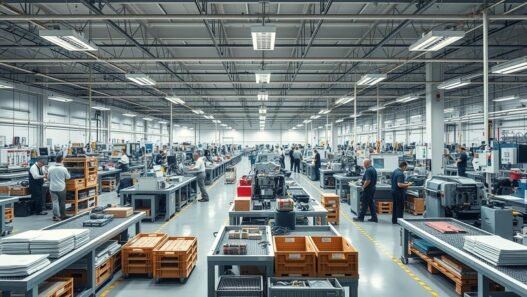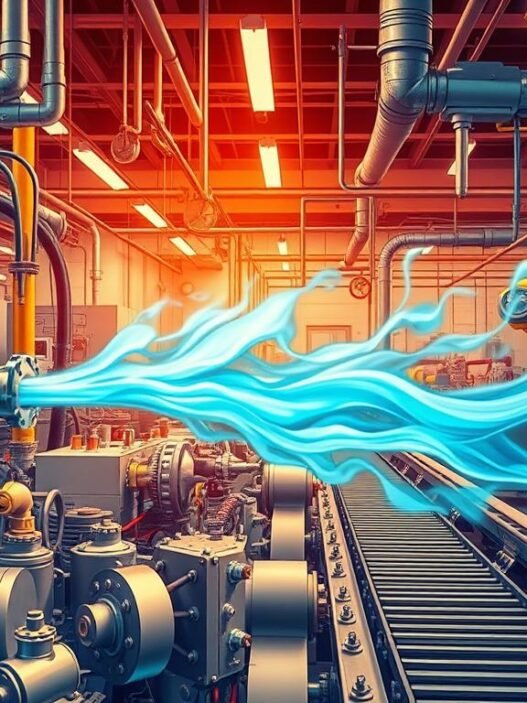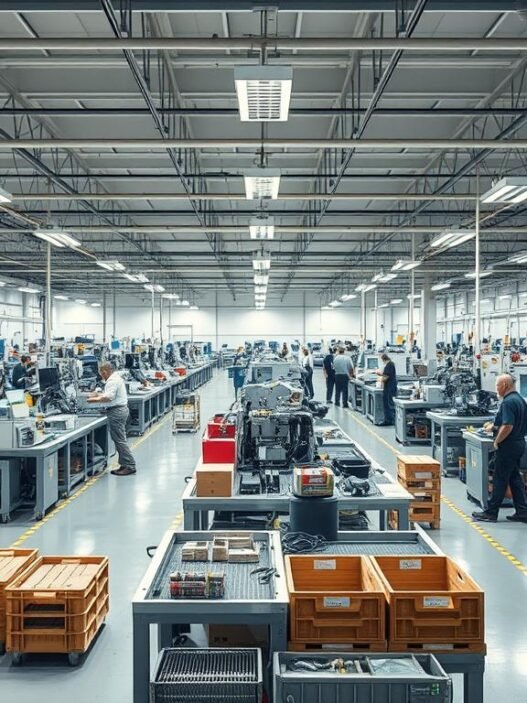Did you know hydraulic systems can create forces over 10,000 psi? This amazing power is used in many applications. For example, it powers elevators and massive construction machinery. These systems use the basic principles of hydraulic mechanics to work well and effectively.
Pascal’s Principle is at the heart of hydraulic systems. It says any pressure change in a confined fluid spreads evenly. This allows hydraulic systems to increase force. This makes it possible to lift heavy things with smaller parts. These systems are used in cars and industrial machines. They include parts like reservoirs, pumps, valves, and cylinders.
This article talks about the main parts, roles, and uses of hydraulic systems. It shows why they are important in many industries and our daily lives.
Key Takeaways
- Hydraulic systems can produce high force and speed due to the incompressibility of fluids.
- Pascal’s Principle is foundational for understanding how pressure affects hydraulic systems.
- These systems are essential in various applications, including construction, automotive industry, and more.
- Hydraulic components consist of pumps, reservoirs, valves, and cylinders that work together to operate machinery.
- Hydraulic pumps typically found in the market are positive displacement pumps, delivering exact fluid amounts for high-power tasks.
What Are Hydraulic Systems?
Hydraulic systems play a vital role across many fields. They use fluid to transfer energy. This setup includes parts like pumps, valves, and cylinders. Together, they change mechanical energy into hydraulic power. Machines such as excavators and backhoes need this technology to work well.
These systems are key for lifting heavy items and generating a lot of force. They’re used in building projects, car industries, and making products like plastics. Hydraulics work under high pressure, up to 10,000 psi. This is much more than air-powered systems can handle.
- Force multiplication: Hydraulics make it easier for machines to do tough jobs.
- Compact design: They fit in smaller spaces than many mechanical systems.
- Efficient energy transfer: The fluid’s nature means less energy is lost while moving power.
Hydraulics are crucial for many industry tasks, ensuring work goes smoothly and safely. Cars use hydraulic brakes for strong stopping power. In waste management, hydraulics power machines that crush trash, making the process more efficient. This technology is a game-changer for both work and fun.
| Industry | Hydraulic Applications | Examples of Machinery |
|---|---|---|
| Construction | Excavators | Backhoes |
| Manufacturing | Plastic Injection Molding | Stamping Machines |
| Waste Management | Trash Compactors | Roll-off Trucks |
| Automotive | Braking Systems | Power Steering |
How Do Hydraulic Systems Work?
Hydraulic systems use fluid mechanics principles to work efficiently. They employ fluid pressure to send force and energy around the system. To understand them, we must look into Pascal’s Law and how liquids don’t compress.
Principle of Pascal’s Law
Pascal’s Law is key to understanding hydraulics. Blaise Pascal found that pressure on a fluid spreads equally everywhere. This means a small force on a piston can make a much bigger force elsewhere. For instance, a 5-pound force might result in a 50-pound force due to fluid pressure. This ability makes hydraulic systems strong and useful, from construction to cars. Find out more about how this works in hydraulic systems here.
Understanding Incompressibility of Liquids
Liquids being incompressible is crucial for hydraulic systems. They keep their volume under pressure, unlike gases. Because of this, when pressure changes in one place, the whole system feels it. This makes transferring energy reliable, letting hydraulics turn hydraulic energy into movement. This reliability is vital for industries like agriculture and industrial machinery that depend on hydraulic systems.
Key Components of Hydraulic Systems
Hydraulic systems depend on several key components to work properly. These parts are essential for turning and moving energy efficiently. They ensure the system operates smoothly and reliably.
Reservoirs
Hydraulic reservoirs are crucial to these systems. They hold the fluid, cool it down, and let air out. A good reservoir keeps the pumps filled with fluid, making up for any that’s lost. They also help remove some contaminants from the fluid, making the system last longer.
Pumps
Hydraulic pumps are the heart of these systems. They change mechanical energy into hydraulic energy. This lets the oil flow through the system. You’ll find gear and piston pumps mostly used. Gear pumps are small and tough. Piston pumps can handle higher pressures. The choice depends on the system’s needs.
Valves
Valves control the fluid’s direction and pressure in the system. They are vital for its performance. There are different valves for specific tasks. This lets you control the fluid flow accurately. Choosing the right valve is key to making the system work well.
Cylinders and Actuators
Cylinders and actuators turn hydraulic energy into mechanical energy again. Cylinders are for moving straight, and motors for turning. They’re made to match the job’s demand in terms of size and length. High pressure in these parts allows for strong lifting and moving actions. It shows the power of hydraulic systems.
The Role of Hydraulic Fluid
Hydraulic fluids are key to running hydraulic systems smoothly. They help in transmitting power. They also lubricate, control heat, and keep the system clean from contaminants. It’s important to know about the different types of hydraulic fluids and their features. This helps in choosing the right fluid for each job.
Types of Hydraulic Fluids
There are many types of hydraulic fluids, each with its own benefits. Here are some common ones:
- Petroleum-based fluids: They’re known for their great lubrication and heat tolerance.
- Water-based fluids: These are less likely to catch fire and are better for the environment, making them a good choice for certain uses.
- Biodegradable alternatives: These are becoming popular for their low impact on the environment. They are great for businesses that want to be green.
Each type is designed for specific needs. Some resist heat well and others prevent oxidation.
Importance of Fluid Viscosity
Viscosity is critical in hydraulic systems. It affects how the fluid performs and the system’s overall efficiency. As it gets warmer, fluids tend to get thinner, which can change how they flow and lubricate. There are several key things to remember about viscosity:
- Thicker fluids might slow down flow rates and affect how fast a system responds.
- Thinner fluids can work better in higher temperatures, helping to transmit power more effectively.
- The best fluids keep their thickness in the normal operating temperature range of 100°F to 140°F.
Choosing the right hydraulic fluid means considering temperature, workload, and the system’s parts. The right viscosity keeps the system efficient, reduces wear on parts, and ensures it runs smoothly for various industrial uses.
| Hydraulic Fluid Type | Key Characteristics | Ideal Applications |
|---|---|---|
| Petroleum-based | High thermal stability, effective lubrication | Heavy machinery, automotive |
| Water-based | Low flammability, environmental safety | Construction, mining |
| Biodegradable | Eco-friendly, minimizes environmental impact | Agriculture, forestry |
Keeping these points in mind ensures the system works its best. This makes hydraulic systems last longer and be more reliable.
Types of Hydraulic Pumps
Learning about hydraulic pumps is key for hydraulic systems to work well. There are two main kinds: positive displacement pumps and non-positive displacement pumps. Each kind has a unique role, helping to achieve the correct flow and pressure for various needs.
Positive Displacement Pumps
Positive displacement pumps are widely used in hydraulic systems. They provide a steady amount of fluid in each cycle. This ensures a constant flow regardless of pressure changes. Thanks to this, they work very efficiently with little waste.
The main types of positive displacement pumps include:
- Gear Pumps: Predominant in truck-mounted hydraulic applications.
- Piston Pumps: Suitable for high-pressure applications; they have both fixed displacement and variable displacement designs.
- Vane Pumps: Previously popular in utility vehicles, now largely replaced by gear pumps.
Each design has its pros and cons, fitting different needs. For instance, piston pumps are great for high pressures but can be costly initially.
Non-Positive Displacement Pumps
Non-positive displacement pumps, like centrifugal and propeller types, allow fluid to flow freely. These pumps don’t seal entirely against fluid loss, making them ideal for less pressure. They fit well in situations that need variable flow rates.
These pumps are chosen for their ability to provide a stable flow without precise control over volume. This makes them useful in many industrial and hydraulic settings.
| Pump Type | Key Features | Common Applications |
|---|---|---|
| Positive Displacement | Consistent flow, minimal slippage | High-pressure systems |
| Gear Pump | Common design, robust | Truck-mounted systems |
| Piston Pump | Capable of high pressures, complex | Heavy industrial applications |
| Vane Pump | Lower cost, replaced by gears | Utility vehicles (less common now) |
| Non-Positive Displacement | Variable flow, flexible | Low-pressure applications |
Applications of Hydraulic Systems
Hydraulic systems are key in many fields due to their power and flexibility. They turn simple mechanical energy into strong hydraulic force. This makes them vital in construction, automotive, and industrial equipment.
Construction Machinery
Hydraulics boost productivity and efficiency in the construction world. Machines like excavators and cranes rely on them for heavy tasks. This power helps with jobs such as digging and moving concrete while cutting down on hard labor.
The use of hydraulics in building gear takes away much of the manual work. It lightens the load for tough jobs.
Automotive Applications
In the automotive industry, hydraulics are found in brakes, steering, and lifting parts. This makes repairing heavy cars easier and safer. These systems help many other car parts work better, making them key to modern vehicles.
Industrial Equipment
Hydraulic systems boost the ability of machinery in various fields. They’re used in manufacturing presses, lifts, and robots that need a lot of force and accuracy. Waste management and warehousing also rely on hydraulics for easier operations.

| Industry | Hydraulic Application |
|---|---|
| Construction | Excavators and cranes for heavy lifting |
| Automotive | Brakes and steering systems |
| Industrial | Presses and robotic devices |
| Aerospace | Controlling aircraft flaps and landing gears |
| Marine | Cargo management and crane operations |
| Agriculture | Field cultivation and crop harvesting |
Open vs. Closed Hydraulic Systems
Hydraulic systems are mainly of two kinds: open and closed. Both types have their own features, making them fit for different uses. It’s important to know the differences to choose the right one for the job.
Characteristics of Open Systems
Open hydraulic systems have a steady flow of fluid. They work at lower pressures, perfect for machines that don’t need much power. These systems often use a smaller gear pump, which cuts down costs.
For example, farm tractors usually have open systems. They use them for plowing and seeding because they’re simple and cheap.
Characteristics of Closed Systems
Closed hydraulic systems keep the pressure constant and can create more power. They are more complex and need bigger pumps to work well. You often see them in places that need precise and strong movements, like in factories.
These systems are great for tasks like pressing or lifting heavy loads. Even though they’re pricier and can get hotter than open systems, they save fuel. They do this by not needing constant high pressure.
How Hydraulic Systems Multiply Force
Hydraulic systems are powerful in increasing force using hydrostatics principles. Pascal’s Law shows how pressure and area connect to boost force. Simply, making the piston area larger raises the force applied. This principle has transformed many industries by offering a big mechanical advantage.
Understanding Force Multiplication
The rule for multiplying force with hydraulics is found in certain formulas. The equation F1/A1 = F2/A2 means a small piston with force (F1) on a small area (A1) can make a bigger force (F2) on a larger area (A2). This tells us that with smart design, lifting heavy objects needs less effort.
Examples of Force Application
Hydraulic systems are everywhere, making things work better and stronger. In factories, they power presses to bend or mold metal and plastic. Cars use them for brakes, steering, and suspensions. This shows how key hydraulic tech is in making vehicles.
Aircraft rely on these systems for crucial parts like landing gear and flaps, ensuring they function safely. On construction sites, hydraulics power diggers and cranes for heavy lifting and digging. Their strong performance in tough settings highlights their efficiency. For more, visit this resource.
Advantages of Hydraulic Systems
Hydraulic systems are vital in many industries for their heavy machinery and equipment. They are known for their power, efficiency, and flexible design.
Power and Efficiency
These systems generate great force from small components. This lets them lift heavy items with ease, important for cranes and excavators. They handle huge weights fast, even under extreme pressure.
Compared to electrical or mechanical systems, hydraulic ones are far more efficient. They’re perfect for tasks that demand a lot of power.
Flexibility in Design
Hydraulic systems adapt well to different setups. They can move fluid through small pipes efficiently. Easy controls like levers and buttons make operation simple.
With fewer parts than pneumatics, they wear down less. This makes them more durable and reliable.

Maintenance is easier with hydraulic systems too. They’re used in car brakes and construction gear, showing their strength. Routine maintenance like changing filters is usually all that’s needed, cutting down costs.
| Feature | Hydraulic Systems | Electrical Systems | Pneumatic Systems |
|---|---|---|---|
| Noise Level | Quieter | Noisy | Noisy |
| Maintenance Cost | Low | Higher | Moderate |
| Force Generation | High | Moderate | Low |
| Adaptability | High | Low | Moderate |
| Durability | High | Moderate | Low |
Hydraulic systems combine power, efficiency, and flexible design. They are chosen for many fields like construction and auto industries. They deliver innovative and dependable solutions. For details on hydraulic system efficiency, see this guide on financial assessments.
Limitations of Hydraulic Systems
Hydraulic systems are efficient and strong. Yet, they have limits we must understand. Knowing these limits helps in better operation and care. This way, we can prevent and manage problems well.
Potential for Fluid Leaks
Leaks are common in hydraulic systems, affecting their function and safety. Over time, parts like fluid lines and seals might wear out. This leads to hydraulic system limitations. Spotting leaks early is crucial to avoid inefficiency and expensive fixes.
Leak cleanups can be costly. Also, hydraulic fluids can harm the environment and our health. So, it’s vital to deal with leaks swiftly.
Maintenance Requirements
Keeping a hydraulic system in top shape requires regular checks. These checks help keep fluid levels right, swap out dirty fluid, and catch leaks or wear early. Without this care, the system can break down, costing more to fix.
Skilled technicians are needed for precise upkeep. Not doing proper maintenance can lead to big problems. This includes unexpected shutdowns and damage.
| Issue | Impact | Mitigation Strategy |
|---|---|---|
| Fluid Leaks | Decreased system performance and safety hazards | Regular inspections and swift repairs |
| Contamination | Higher repair costs and system inefficiencies | Routine fluid replacement and monitoring |
| Temperature Fluctuations | Potential overheating and freezing issues | Use of appropriate hydraulic fluids for environmental conditions |
| Pressure Spikes | System failures and maintenance costs | Installing pressure relief valves |
Future Trends in Hydraulic Technology
The future of hydraulic systems looks bright, with many new advancements. Now, we have electrically controlled hydraulic systems. These mix hydraulic power with electronic control. This means better precision and more flexibility. Energy efficiency and sustainability are also key. Innovations like variable pumps and regenerative braking save energy and boost performance.
Digitalization and IoT are changing hydraulic technology. They bring condition monitoring, predictive maintenance, and remote control. Smart controls use machine learning and AI. This could change how hydraulic systems work, making them more adaptable.
New materials and manufacturing make hydraulic parts compact and light. This is great for industries like robotics and aerospace. Hybrid systems combine hydraulic and electric tech. They are popular in vehicles and construction for better fuel use and power.
Safety is more important than ever in hydraulics. Devices like pressure valves and fail-safe mechanisms are vital. Predictive maintenance uses sensors and analytics to improve safety and cut downtime. The market for hydraulic equipment is growing fast. It went from USD 43,825 million in 2021 and might reach USD 62,375 million by 2030.
In agriculture, automation is a big trend. Precision farming uses sensors and actuators for better farming. This makes farming more resource-efficient and sustainable. Hydraulic cylinders are key in tough conditions, used widely across industries.
Hydraulic systems are still chosen over electrical actuators for heavy tasks. This keeps the demand for domestic hydraulic makers strong. Future changes in hydraulic cylinders will likely aim for better energy use. Custom solutions, like those from Aggressive Hydraulics with their Purpose-Built™ cylinders, are on the rise.
Explore more about the future trends in.
Conclusion
An in-depth look at hydraulic systems shows their vital role in different fields. This includes construction, automotive, and manufacturing. Hydraulics, with their central parts and complex uses, have changed the way we work. They make it possible to apply a lot of force with little effort, boosting work efficiency and precision.
This tech keeps getting better, with new electronic controls and more powerful designs. These advances promise to make hydraulic systems even more reliable and effective. As the field keeps evolving, the takeaway is clear. Hydraulics are essential in engineering today.
With the integration of the Industrial Internet of Things (IIoT), the outlook for hydraulics is even brighter. This technology will improve monitoring and maintenance. It ensures that hydraulic systems can only get better. This promises progress and efficiency in areas from building machines to flying airplanes.















